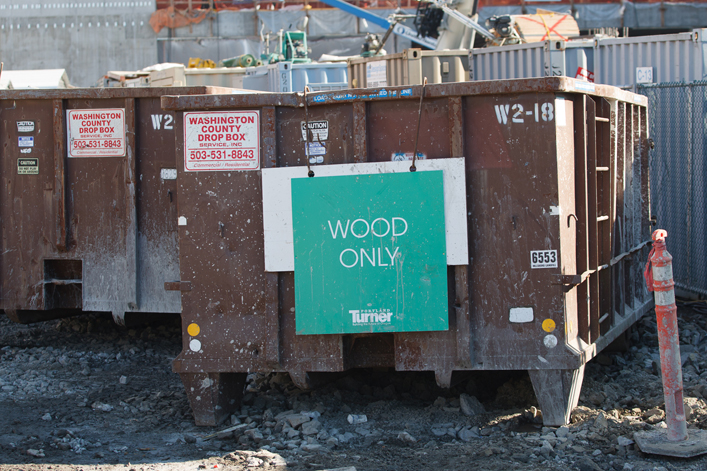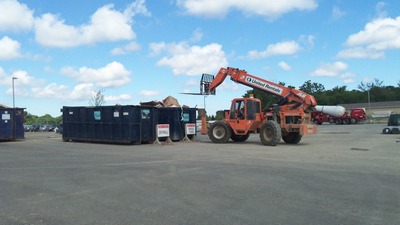
Sustainable strategies green up the environment
By Chris Schmidt
 Eight thousand pounds of waste are typically thrown into the landfill during the construction of a 2,000-square-foot home, according to Construction Waste Recycling's website. Now imagine the waste produced during the construction of a 40,000-square-foot commercial building. Thankfully, numerous construction companies have added benchmarking and innovative Lean, green and sustainability strategies to their toolboxes.
Eight thousand pounds of waste are typically thrown into the landfill during the construction of a 2,000-square-foot home, according to Construction Waste Recycling's website. Now imagine the waste produced during the construction of a 40,000-square-foot commercial building. Thankfully, numerous construction companies have added benchmarking and innovative Lean, green and sustainability strategies to their toolboxes.
“We have worked with sustainably oriented clients in terms of construction waste management for many years,” says MYCON General Contractors’ Vice President of Retail Services Justin Jeffus, LEED A.P. “One major discount box store initiated recycling programs that divert waste away from five different waste streams for masonry/concrete, general trash, wood products, steel and cardboard,” says Jeffus. “For another national electronics and technology retailer whose projects are LEED-driven, waste diversion is a huge priority due to points needed to obtain certification,” says Jeffus. “When we implemented steel recycling about five years ago, there was a dual purpose: to recycle the material and to develop a small revenue stream from monies paid by steel recycling facilities for that material.”
Several companies have recently been recognized for their innovative efforts. For example, in June, Waste Management announced the winners of the 2015 “Sustainability Circle of Excellence Award,” a recognition given to the top waste reduction customers in the construction industry whose various projects achieved outstanding sustainability milestones.
“Waste Management has a long history of working with customers to reach their waste and recycling goals,” stated Kenny Lark, Waste Management director of construction strategic accounts. “Within the construction industry, this has become increasingly more important to owners, developers and investors with the heightened interest in LEED certification and green building practices.”
Lark explained in order to easily create a project waste management plan, track and chart results during the project and document waste diversion rates and volumes, Waste Management developed the Diversion and Recycling Tracking Tool, also known as DART.
This year's winning companies diverted the highest total tonnage for recycling in 2014, as measured by DART. In total, these companies put over 90 thousand tons of materials to reuse and achieved a 70 percent diversion rate:
 Balfour Beatty Construction, LLC
Balfour Beatty Construction, LLC- Gilbane Building Company
- J.H. Findorff & Son, Inc.
- M.A. Mortenson Company
- Robins & Morton
- Skanska USA, Inc.
- Wespac Construction, Inc.
- The Whiting-Turner Contracting Company
- Walsh Construction
- W.M. Jordan Company
According to WM, Robins & Morton's diversion efforts ranked among the top five percent of contractors using the DART tool. And, so far in 2015, the company has diverted more than 10,000 tons of construction and demolition waste from landfills, averaging an 88 percent waste diversion rate.
Balfour Beatty, another winner of Waste Management's sustainability award, is listed on the Dow Jones Sustainability Index. To date, the company boasts 71 percent total construction waste diverted from landfill.
 One company implementing its own waste tracking is Turner Construction. According to Chris McFadden, vice president of communications at Turner, the company utilizes TurnerTracker, a cloud-based tool, for tracking construction waste diverted from landfills. Diverted material is sorted by type and prepared for its new life; concrete is crushed to become aggregate or fill and rebar is melted down and reformed. In some cases, waste material is diverted for reuse on the same project. For example, at the Sacramento Entertainment and Sports Center project, future home of the Sacramento Kings, the project team is recycling more than 90 percent of its construction waste (total waste during the demolition phase was estimated at 96,000 tons), including crushing demolished concrete to serve as part of the new arena's foundation.
One company implementing its own waste tracking is Turner Construction. According to Chris McFadden, vice president of communications at Turner, the company utilizes TurnerTracker, a cloud-based tool, for tracking construction waste diverted from landfills. Diverted material is sorted by type and prepared for its new life; concrete is crushed to become aggregate or fill and rebar is melted down and reformed. In some cases, waste material is diverted for reuse on the same project. For example, at the Sacramento Entertainment and Sports Center project, future home of the Sacramento Kings, the project team is recycling more than 90 percent of its construction waste (total waste during the demolition phase was estimated at 96,000 tons), including crushing demolished concrete to serve as part of the new arena's foundation.
“We recognize that our responsibility includes not just what we build, but how we build it,” said Michael Deane, Turner's chief sustainability officer. He continued, “We are aware of the effect of our operations — including jobsite energy and water efficiency, and waste diversion. TurnerTracker is a tool that will help us monitor and report on our construction waste recycling in a much more streamlined and detailed way. We are measuring construction waste diversion as one piece of our broader effort to achieve our sustainable goals.”
Sundt Construction, a company utilizing an in-house tracking tool, diverted recyclable materials from landfills, such as concrete, asphalt and steel for reuse while involved with the design-build team that worked on the LEED Silver-certified San Diego City College Math and Social Sciences Building and Parking Structure in San Diego, California. On this project, Sundt salvaged 82 percent of materials and recycled 971 tons, including 561 tons of concrete.
According to Sundt Project Director John Messick, while recognizing that waste diversion was an important component in the company's overall approach to sustainability, the project team worked with several companies to maximize job site recycling. Examples of the diversion efforts required for LEED certification included:
- Concrete: Concrete was isolated in separate containment bins to ensure all materials were recycled.
- Wood: The majority of the wood recycled came from concrete forms, which were disassembled when the building frame was erect. Miscellaneous wood that came to site via deliveries (pallets, packing materials) were separated from general rubbish and recycled throughout the project.
- Metal studs and drywall (gypsum): During the interior build-out, two recycling bins were maintained onsite—one to capture and collect metal studs and the other to collect drywall; both materials were diverted from landfills.
- General waste was screened prior to being sent to landfills, which removed metals, plastics and other recyclable materials.
- Soil: When digging a trench, soil was tested to ensure it was not contaminated; all uncontaminated soil was recycled.
As more companies employ green building efforts to meet LEED certification and/or sustainability goals on the jobsite, it's a win-win for the environment and future generations to come.
For other waste diversion goals and strategic resources, visit http://www.epa.gov/oaintrnt/waste/goals.htm. For information on LEED for New Construction & Major Renovations, visit http://www.usgbc.org/Docs/Archive/General/Docs1095.pdf.


 Join our thriving community of 70,000+ superintendents and trade professionals on LinkedIn!
Join our thriving community of 70,000+ superintendents and trade professionals on LinkedIn! Search our job board for your next opportunity, or post an opening within your company.
Search our job board for your next opportunity, or post an opening within your company. Subscribe to our monthly
Construction Superintendent eNewsletter and stay current.
Subscribe to our monthly
Construction Superintendent eNewsletter and stay current.